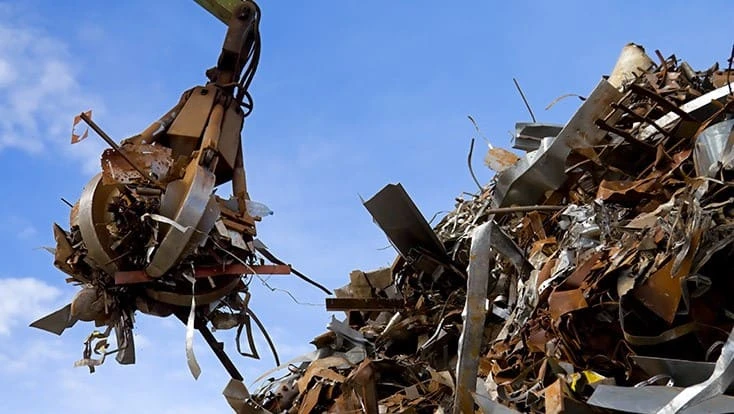
Photo provided by Dreamstime.
Ferrous scrap prices rose in the early March buying period, and prompt scrap retained its wide margin in value over obsolete scrap grades. Processors and traders are far from unified in their guesses as to where the market will head in April.
The direction of the national and global economies, the habits of overseas buyers and late winter weather each could produce surprises in March that will affect either supply or demand and, ultimately, April prices.
The Midwest Index prices for three benchmark grades released by Fastmarkets AMM March 10 showed gains of from $48 to $59 per ton, while the publication’s March 10 West Coast price rose by $40 per ton compared with early February. The East Coast price, meanwhile, rose by a more modest $14 per ton.
In early March, Nathan Fruchter of New York-based Idoru Trading Corp. expresses optimism about overseas demand, saying, “There’s good demand across the globe. Turkish rebar export prices are up, so there’s more demand for scrap.”
By the second week in March, however, trade publications are reporting reluctance in some overseas markets to pay more for scrap from the United States. Davis Index reports March 11 that buyers in both Turkey and India are offering lower bids based on what they perceive as abundant global scrap supplies.
In the domestic market, a scrap processor in the Great Lakes region says uncertainty is widespread as to whether supply is meeting or even exceeding demand.
“We kept hearing about a shortage of scrap for March, much like January, but as the day went on yesterday, I had a hard time placing some final tons of busheling and heavy melting steel (HMS),” the processor says as of the second week of March.
Some mills in the region, the processor says, were reducing the size of their orders, with one EAF mill telling him it could not “take another pound” as of the second week of March.
Repeating a long-lasting historical pattern, mills and processors are wary of each others’ physical positions in the market, the scrap dealer says. “There is some disconnect (or reluctance to divulge) between the mills and dealers over how busy dealers are and the scrap they have available."
He continues, “When I talk to drivers, they say the pads are full at the mills and it doesn’t look like there is a shortage. It is hard to say if there are either subpar flows or high demand because what is being said and reported and what is actually happening are contradicting each other.”
Fruchter and the Great Lakes region processor predict price swings will continue beyond winter and into the spring and early summer. “I definitely see export prices for late March and into April moving up,” says Fruchter, citing “good overall demand out there.”
The processor says, “The further we get into 2021, the more I feel we will continue to see $50 swings through the second quarter. As long as we continue to see these $50 swings, we’ll see dealers hold in months like February, only to flood the market the following month.”
On the scrap generation side, stable-to-rising prices for not just ferrous but also for copper and aluminum scrap have helped sustain flows of obsolete scrap into shredder yards and feeder yards.
The generation of prompt scrap continues to be hampered by a still semidormant aerospace sector. That manufacturing sore spot has been joined by a shortage of semiconductor chips to the automotive industry, which reportedly has slowed output at numerous auto plants.
Chips produced in Asia are being consumed by a computer market that has gone into overdrive because of work-from-home and learn-from-home protocols tied to COVID-19.
Fastmarkets AMM says the automotive sector absorbs about 12 percent of semiconductor chips, which is not enough market share to give it sufficient clout for its deliveries to supersede those of computer and telecom equipment original equipment manufacturers.
On the demand side, economists and investors are anxious to see how a more thoroughly vaccinated U.S. population might spur a rising gross domestic product (GDP) figure and increased demand for energy and travel services and goods that have been hampered by social distancing protocols.
The New York-based Conference Board offers as its “upside forecast” 2021 GDP growth in the U.S. that checks in at 6.5 percent, if “new COVID-19 cases fall dramatically [and] vaccines are universally available” in the second quarter.
The research and policy advocacy firm’s upside scenario also involves social distancing policies being “virtually eliminated” in the second quarter and the passage of the $1.9 trillion stimulus bill and its efficient “deployment.”
Steel producers in the U.S. continue to make and ship more steel, inching toward levels last reached in the pre-COVID-19-protocols era represented by February 2020, according to the Washington-based American Iron and Steel Institute (AISI).
AISI says U.S. mills in January 2021 shipped more than 7.4 million tons of product, representing a 5.3 percent increase from the previous month. That level of shipments, however, remains 13.1 percent lower compared with the more than 8.5 million tons shipped in January 2020, pre-COVID-19 impacts.
Latest from Recycling Today
- Unifi launches Repreve with Ciclo technology
- Fenix Parts acquires Assured Auto Parts
- PTR appoints new VP of independent hauler sales
- Updated: Grede to close Alabama foundry
- Leadpoint VP of recycling retires
- Study looks at potential impact of chemical recycling on global plastic pollution
- Foreign Pollution Fee Act addresses unfair trade practices of nonmarket economies
- GFL opens new MRF in Edmonton, Alberta







